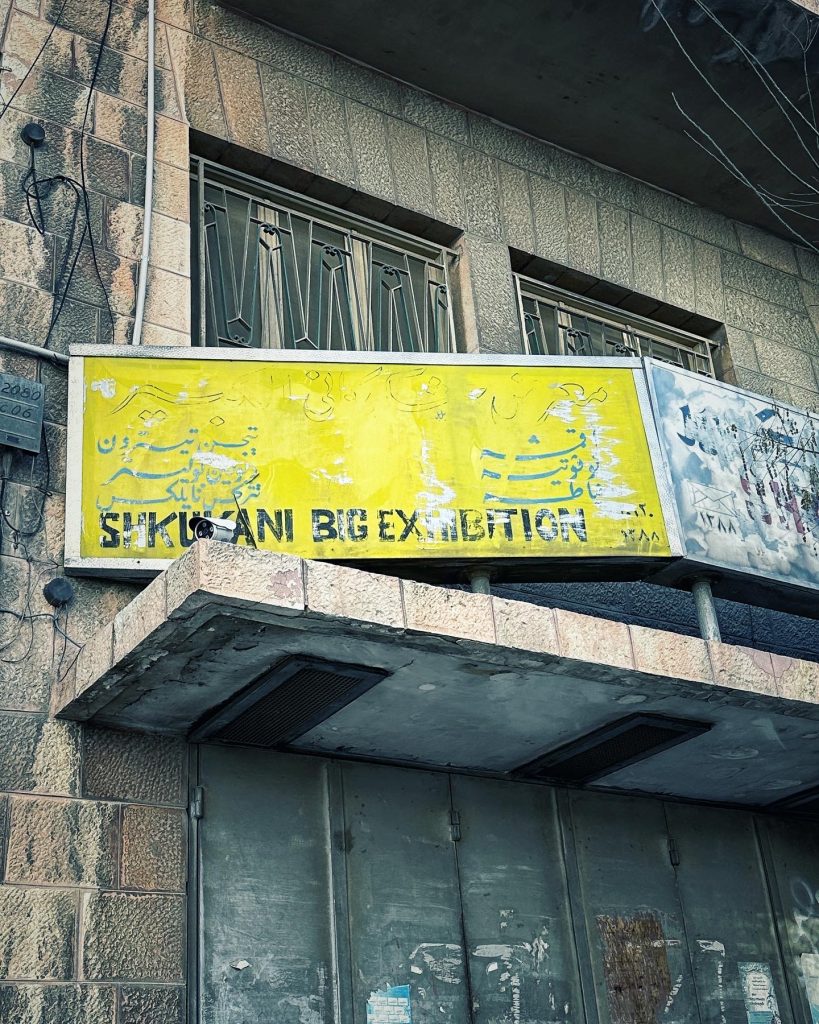
Jabal al-Hussein walk and talk. Episode 5.
I once dreamt that I was transported back in time and drove through the streets of Amman, maybe in the 1960s. Who were those people who built these handsome houses? Who opened the shops with neatly calligraphed signs. And, if many of them still dreamt of returning to a lost homeland, why did they still manage to build a city that held so much promise?
—
“I need a coffee,” I told Hussein, just as we were passing one of those coffeeshops with very large red signs that popped up all over Amman in the past two decades.
We ordered two Sada coffees. The order was taking time. The barista was out of the shop. So we waited in front of the building.
Hussein’s keen eye immediately caught two things. First, the neat metal work of the building’s door, then, the faded sign hanging above our heads. Hussein is THE expert on old Amman shop signs, so of course he would catch this one.
With some difficulty I was able to decipher some of the words. The shop was called Shkukani Big Exhibition. In neat commercial Farsi script, the hand-painted, bilingual sign announced: fabrics, nouveauté, tailoring. So this must have been one of the early fashion stores on the main street, Khalid bi Alwaleed, that passes through the entirety of the Jabal al Hussein district, connecting the northern tip of Amman’s Citadel Mount to the Interior Ministry Circle. If anything, Al-Hussein is a fashion district. As a teenager it was still the place my friends and I shopped for clothes. The upper part of Al-Hussein is still a sprawling, busy clothing and fashion market, though it has been eclipsed by Amman’s many shopping malls.
The word “nouveauté” has always fascinated me. Its use to denote a fashion store was ubiquitous in the 1970’s and 1980’s. Today you can still see it in use, but mostly on low-end, small clothing stores. But in the past it must have carried an air of worldly sophistication. I thought that “nouveauté” is used in France to mean “fashion” or “fashion store” but I was mistaken. It simply means “new things”. Maybe its usage came to Amman through the more sophisticated francophone Arab capitals of the 20th century like Cairo or Beirut.
The more fascinating words on the sign were what sounded like Western brand or fabric names: fancy sounding words like “Tigen, Titron, Diolin, Polyester”. I am unsure if I am getting these words right. But I can imagine the ladies of Jabal al Hussein some 60 years ago flocking to the Big Shkukani Exhibition for the latest and greatest in fashion and fabrics with fancy names.


Of course you cannot linger outside a building in Amman (and take photographs) without an owner or resident appearing almost out of nowhere, asking you what you are doing or if you want anything. And indeed, and elderly gentleman appeared. I immediately explained that I was a graduate of the nearby Hussein College and that my friend and I were doing a nostalgia tour. A friendly exchange immediately ensued.
The man was a member of the Shkukani family. His father and uncle build the building in the mid 1960’s. I presumed that the fashion store was his father’s. Today it is shuttered and used for storage. The man explained that their family were refugees from Al-Lidd (Lydda) in Palestine, which is a town close to Ramla. He added that the Zionist forces expelled almost all Arabs from Al-Lidd in 1948, because it was a center of resistance to their plans. He also added that Al-Lidd was very old and was considered the capital of Palestine in ancient times.
—
I travel in my dreams to the streets of Amman in the 1960s. I arrive on the day the sign of the Shkukani Big Exhibition was being installed, brand new and vibrant. Refugees who lost their homeland, were building a stone building, opening a “nouveauté” with fancy goods. Hiring professional calligraphers to announce the venture.
—
Our coffees arrived and we were on our way to the next stop.
Leave a Reply